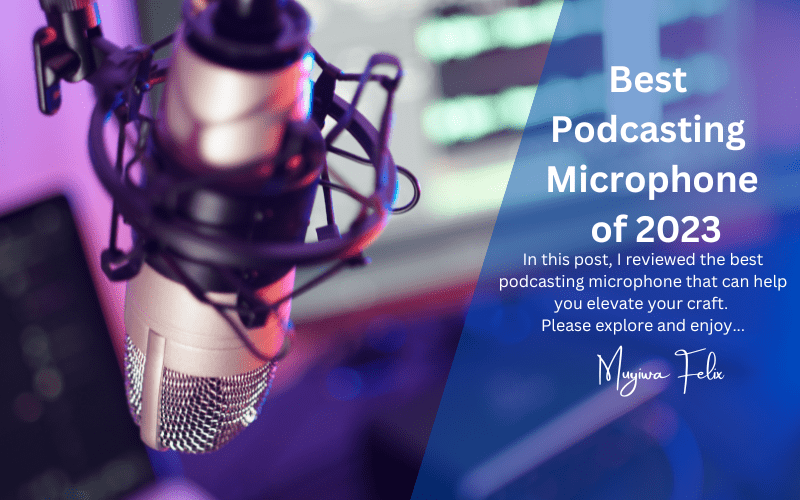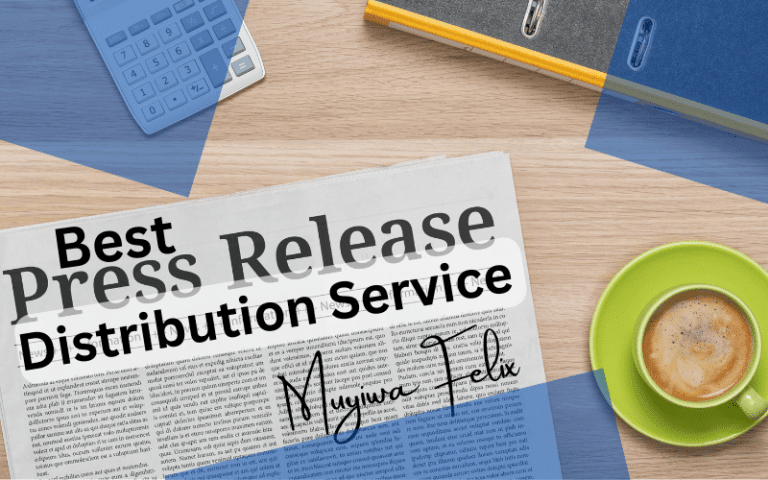Best Podcasting Microphones for 2024

I struggled to decide on the best podcasting microphone to buy when I was about to start my podcast. So, I understand your plight if you’re going through the same situation.
Podcasting has exploded in popularity over the past decade, and with good reason. Podcasts offer a convenient way to consume content on various topics, from true crime and politics to pop culture and personal development.
Whether you’re an aspiring podcaster or a seasoned pro, having the right microphone is crucial for creating high-quality audio. In this article, we’ll take a closer look at some of the best microphones for podcasting and some key factors to consider when choosing a microphone for your show.
One of the most popular choices for podcasting microphones is the dynamic microphone. Dynamic microphones are known for their durability and versatility, making them an excellent option for beginners and professionals. They can handle a wide range of volume levels and are resistant to feedback, which makes them ideal for recording in noisy environments. Some popular dynamic microphones for podcasting include the Shure SM7B, the Heil PL-2T Overhead Boom, and the Electro-Voice RE320.
Another popular option for podcasting microphones is the condenser microphone. Condenser microphones are known for their excellent sensitivity and clarity, making them ideal for capturing detailed audio. They are generally more sensitive than dynamic microphones. They require more setup and must be plugged into a preamp or interface to work correctly. Some popular condenser microphones for podcasting include the Rode NT1, the Audio-Technica AT2020, and the Neumann TLM 103.
As far as microphone goes, there are many USB microphones specifically designed for podcasting. These microphones plug directly into your computer via USB, making them an excellent option for beginners or those who want to avoid setting up an external preamp or interface. Some popular USB microphones for podcasting include the Blue Yeti, the Samson G-Track Pro, and the Audio-Technica ATR2100x-USB.
What factors should I consider before choosing a Podcast Microphone?
The microphone that suits your podcasting environment
When choosing a microphone for podcasting, it’s essential to consider a few key factors. The first thing to consider is the type of microphone that will best suit your podcasting environment.
A dynamic microphone is more compatible with the dynamic range of a Public Address system; hence more suitable for use in a less-controlled, open-air environment.
On the other hand, condenser microphones are more sensitive and perform excellently in a quiet and more controlled environment. Therefore, for podcasting purposes, a condenser microphone is much more suitable.
Both Condenser and Dynamic Microphones offer unique qualities.
Dynamic microphones are generally more durable and versatile, while condenser microphones offer greater sensitivity and clarity.
You’ll also want to consider the size and shape of the microphone, as well as any additional features it might offer, such as built-in pop filters or shock mounts.
Price of the Microphone
Another essential factor to consider is the price of the microphone. While it’s true that you get what you pay for when it comes to audio equipment, it’s also essential to find a microphone that fits your budget.
For starters, I recommend USB microphones or dual connectivity microphones, i.e., microphones with USB+XLR connectivity. Popular options include Samson, Maono, and Blue Yeti brands.
There are lots of high-quality microphones available at various price ranges. We will explore some of them here.
At this juncture, you must be aware that choosing the right microphone for your podcast is an important decision that can significantly affect the quality of your audio. With the right microphone, you’ll be well on your way to creating professional-quality audio for your podcast.
What is the best podcasting microphone?
There are quite a number of brands and products in the market that can be used for podcasting. Here are my top recommendations for the best podcast microphones in 2023.
1. Samson Technologies Q9U Dynamic Broadcast Microphone, XLR/USB, Black – USB + XLR
Samson Q9U is my top recommendation for a Podcast Microphone. For me, it passes the test of price and versatility. The dual connectivity feature makes Samson Q9U a valuable microphone that you will find useful for a long time, even if you upgrade your setup in the future.
If you’re in the market for a microphone for your podcast, Samson Q9U is an excellent choice. One of the key features that makes it suitable for podcasting is its cardioid polar pattern, which helps to keep your voice front and center by providing excellent off-axis rejection and minimizing ambient pickup.
The microphone picks up sound from the front of the capsule and rejects sound from other directions, which can be particularly useful in a home recording setup where background noise may be an issue.
In addition to its polar pattern, Samson Q9U has several other features that make it suitable for podcasting. The USB-C digital output with 24-bit/96kHz resolution and the XLR analog output provides a range of connectivity options, allowing you to use it with various recording devices.
The 1/8″ output zero-latency headphone monitoring allows you to monitor your recording in real time, while the low-cut filter, mid-presence boost, and mute controls give you the ability to fine-tune the sound of your recording.
The dual-layer windscreen helps to reduce wind noise, and the solid, die-cast construction with an integrated yoke mount ensures that the microphone is durable and easy to use. Overall, these features make this microphone an excellent choice for podcasting.
2. FIFINE Podcast Condenser Mic with Boom Arm, Pop Filter, Mute Button for Streaming – USB Mic
Fifine Podcast Condenser Mic is my second choice podcast microphone. It is budget friendly for starters and easy to use. You only have to plug the USB cable into your laptop and start recording.
The FIFINE Podcast Condenser Microphone is an excellent choice for podcasting due to its wide range of features.
One of the key benefits of this microphone is its plug-and-play design, which means it is ready to use right out of the box with no need for additional plug-ins or complicated setup steps.
It is also compatible with various devices, including Windows, Mac, and PlayStation systems, making it a convenient choice for podcasters who use different recording devices.
The reversible type-c interface and long 8.3ft USB cable make connecting the microphone to your computer easy. At the same time, the touch-mute button and volume knob allows you to control your recording easily.
In terms of sound quality, the upgraded USB condenser microphone capsule and cardioid polar pattern help to produce warm, energetic vocals that are perfect for podcasting.
The included shock mount and pop filter helps to reduce noise and vibrations, further improving the overall sound quality of your recordings. Overall, the FIFINE Podcast Condenser Microphone is a versatile and high-quality podcasting choice that will enhance your audio recordings.
3. Blue Yeticaster Pro Broadcast Bundle with Yeti USB Microphone for Podcasting – USB
The Blue Yeticaster Pro Broadcast Bundle is my third choice recommendation. It is a top-of-the-line solution for podcasting that combines a high-quality Yeti USB microphone with a range of accessories to enhance your recording setup.
The Yeti microphone is known for its unparalleled sound quality and is widely considered a top choice USB microphone on the market. I ranked it lower than Fifine Mic because of the price.
The included Compass Broadcast Boom Arm offers a premium internal spring design and built-in cable management, making it easy to position the microphone for optimal sound quality.
The Radius III Custom Shockmount helps to isolate the Yeti from noise, shock, and ambient vibration, further improving the overall sound quality of your recordings.
The Blue VOICE software allows you to elevate your recordings and streams with clear broadcast vocal sound and a range of voice effects, while the onboard audio controls give you complete control over the recording process.
Whether you want to start a podcast or take your existing show to the next level, the Blue Yeticaster Pro Broadcast Bundle has everything you need to achieve professional-quality audio.
4. Samson Technologies Q2U USB/XLR Dynamic Microphone for Podcasting – USB + XLR
Here is another Samson Product. It is my 4th choice on this list. The Samson Technologies Q2U USB/XLR Dynamic Microphone is an ideal choice for podcasting due to its versatile design and high-quality sound.
The microphone offers USB and XLR outputs, allowing you to connect it to a computer, mixer, audio interface, or portable PA system.
The dynamic microphone capsule with a cardioid pickup pattern is perfect for capturing sound from the front of the microphone while minimizing ambient sounds and room noise, making it an excellent choice for podcasting, home recording, or voiceover work.
The onboard 1/8″ headphone jack allows for zero-latency monitoring so that you can hear yourself in real-time without any delay or echo.
The solid, die-cast construction with a heavy gauge mesh grille ensures that the microphone is durable and able to withstand the rigors of regular use.
The Q2U Recording and Podcasting Pack include everything you need to get started, including an extended desktop stand, a pop filter, and USB and XLR cables. Overall, the Samson Technologies Q2U USB/XLR Dynamic Microphone is a reliable and high-quality podcasting choice that will produce great-sounding results.
5. USB Microphone, MAONO 192KHZ/24Bit Plug & Play PC Computer Podcast Condenser Cardioid Metal Mic – USB
MAONO 192KHZ/24Bit PC Computer Podcast Condenser Cardioid Metal Mic is my 5th choice on this list. It is a feature-rich USB microphone that is well-suited for podcasting.
One of the critical features of this microphone is its professional sound chipset, which allows it to hold a high- sampling rate of 192kHz/24bit. This feature ensures it captures a wide range of frequencies with excellent clarity and detail, making it perfect for reproducing high-quality audio for podcasts and other recording applications.
The microphone is also easy to use, with a plug-and-play design that requires no driver installation. It is compatible with most operating systems, including Windows and Linux (Similar to Fifine Mic recommended above).
The included pop filter and foam windscreen helps to reduce noise and improve the overall sound quality of your recordings, while the shock mount holds the microphone steady with a damping function.
The included scissor arm stand and mounting clamp make it easy to position the microphone for optimal sound capture, and the metal construction of the microphone ensures that it is durable and able to withstand the rigors of regular use.
Overall, the USB Microphone, MAONO 192KHZ/24Bit PC Computer Podcast Condenser Cardioid Metal Mic is a high-quality and reliable choice for podcasting that will surely enhance your audio quality recordings.
6. Shure SM7B Vocal Dynamic Microphone for Broadcast, Podcast & Recording – XLR
And here is my 6th choice podcast microphone – the Shure SM7B. It is a professional-grade microphone designed for podcasting and other recording applications.
It features a dynamic cartridge with a smooth, flat frequency response that captures exceptionally clean and natural sound, making it ideal for reproducing the nuances of the human voice.
The cardioid polar pattern rejects off-axis audio, helping to minimize ambient noise and ensure that the sound of your voice is captured clearly and accurately. The XLR connection allows for greater control over sound quality, and the included pop filter and shock isolation help to eliminate mechanical noise and breathiness.
The microphone also has advanced electromagnetic shielding to defeat hum from computer monitors and other studio equipment.
Overall, the Shure SM7B is a high-quality choice for podcasting. It will enhance the sound quality of your recordings. For this reason, I recommend it.
7. Ovedisa USB Microphone, Professional 192kHz/24Bit Plug & Play PC Computer Condenser Cardioid Mic Kit
Last but not least podcast microphone on my list is the Ovedisa USB Microphone. It is a professional-grade choice for podcasting with a high-quality sound chipset and a range of features.
The Mic has a 16mm capsule design that captures rich, detailed sound with a comprehensive frequency response, and it can support sample rates of up to 192kHz/24bit.
The metal rod body of the microphone is equipped with a shockproof frame and omnidirectional adjustable cantilever bracket, making it easy to install and use in various recording scenarios.
It also offers a plug-and-play design which makes it very easy to use and has no need for driver installation of any sort before it can be used. Ovedisa USB Microphone is compatible with Windows, Mac, and Linux operating systems.
The built-in cardioid capsule captures sound from the front of the microphone, helping to eliminate background noise and ensure that your recordings sound clear and crisp.
Having explored my top choice podcast microphone for content creators, I decided to include the best boom arm that helps you have the best podcasting experience.
Some of the microphones recommended might come with their boom arm, in which case you need not buy a new one.
If your choice microphone does not come with a boom arm, here are a few recommendations that can help you enjoy your podcasting.
Best Boom Arm for Podcast Microphones
1. Pictron Live Broadcast Boom Arm
The Pictron Live Broadcast Boom Arm is my first recommendation. It makes for a perfect podcasting setup. With its professional live broadcast stand design, you can easily turn any tabletop into a professional recording studio in seconds.
The three-arm design allows you to install a camera, microphone, and fill light simultaneously, giving you the flexibility to create a variety of setups for your podcast.
Additionally, the boom arm has multiple expansion device interfaces, including a microphone stand, universal ball head, and 360° cold shoe, making it easy to connect all of your podcasting equipment.
The boom arm is also suitable for most tabletops, with a maximum clamping distance of 50mm and an enlarged clamp seat for added stability. And with its super load-bearing capability, the boom arm can support up to 2kg of equipment, ensuring that your podcasting gear stays securely in place.
Overall, the Pictron Live Broadcast Boom Arm is an excellent choice for podcasting, offering a wide range of features and unparalleled versatility.
2. InnoGear Microphone Arm
The InnoGear Microphone Arm is a versatile and durable option for anyone looking to set up a microphone for podcasting or other audio recording purposes. The included 5/8 “-27 male to 3/8 “-16 female screw adapter makes it easy to connect popular microphones like the blue snowball and HyperX QuadCast.
The arm is suitable for use in a various vasetting, including homes, stages, studios, and more. Its heavy-duty steel structure and super-strong spring make it capable of supporting a load of up to 53oz/1.5kg, ensuring that your microphone stays securely in place.
The foldable armband allows you to easily adjust the angle and height of the boom arm to get the perfect position for your voice, and the upgraded desk mount is built with an anti-scratch pad and a wider mouth to fit most desktops.
Overall, the InnoGear Microphone Arm is a reliable choice for anyone looking to set up a professional-grade microphone setup.
3. Microphone Stand Boom Arm, THRONMAX S3 Adjustable 360° Rotatable Microphone Arm
The THRONMAX S3 Adjustable 360° Rotatable Microphone Arm is an excellent choice for podcasting, with its versatile features and universal compatibility.
The boom arm features a 360° rotatable design, complete with a rotary knob for easy angle adjustment and hand-tightening friction hinges that allow you to adjust without additional tools.
Its dual suspension springs help to protect your microphone from shaking or dropping, ensuring smooth and quiet operation during recording. The scissor arm design is foldable for easy storage transport and equipped with a robust c-clamp for a solid connection to your desktop.
The boom arm also includes a clip-on cable holder for smart cable management, keeping your setup tidy and simple. It is compatible with all Thronmax microphones and other mics with standard 5/8″ or 3/8″ threading and all standard shock mounts.
Overall, the Thronmax S3 Adjustable 360° Rotatable Microphone Arm is a reliable and convenient choice for podcasting.
Omnidirectional vs. Unidirectional Microphone
Omnidirectional microphones are designed to pick up sound equally from all directions. They are often used in situations where the microphone needs to capture a wide range of sounds, such as in a live music setting or in a conference call.
Bi-directional microphones, also known as figure-8 microphones, are designed to pick up sound from the front and back of the capsule but not from the sides. They are often used when the microphone needs to capture sound from two sources on opposite sides of the microphone, such as in an interview setting where the interviewer and interviewee are seated on opposite sides of the microphone.
It’s important to consider the polar pattern of a microphone when choosing one for your specific needs. For example, if you are recording a podcast or conducting an interview, a cardioid or bi-directional microphone might be a better choice because they are more directional and will focus on the sound coming from the front of the microphone. On the other hand, an omnidirectional microphone might be a better choice if you are recording a live music performance or a conference call because it will pick up sound from all directions.
In addition to these main polar patterns, a number of other patterns are less commonly used. These include multi-pattern microphones, which allow you to switch between different polar patterns, and shotgun microphones, which are highly directional and are often used in film and television production to pick up sound from a specific location.
Overall, the polar pattern of a microphone is an important spec to consider when choosing the right microphone for your needs. Whether you need a highly directional or omnidirectional microphone, a variety of options are available to suit your specific needs.
Frequently Asked Questions
The best microphone for podcasting will depend on your specific needs and budget. Some popular options include the Shure SM7B, the Electro-Voice RE20, and the Rode NT1. Ultimately, the best microphone for you will depend on the type of content you produce, your recording environment, and your preferences.
Again, the amount you should spend on a podcasting microphone will depend on your specific needs and budget. Entry-level microphones can cost under $100, while professional-grade microphones can cost several hundred or even thousands of dollars. Finding a balance between price and quality that works for you is crucial.
Using the built-in microphone on your computer for podcasting is possible, but a separate, external microphone will generally provide better sound quality. External microphones also offer more flexibility in terms of placement and the ability to capture a broader range of frequencies.
Both condenser and dynamic microphones have unique strengths and are suitable for different types of content. Condenser microphones are generally more sensitive and capable of picking up a wider range of frequencies, making them well-suited for podcasts that require a high level of clarity and detail. On the other hand, dynamic microphones are better at handling loud sounds and are more resistant to feedback, making them a good choice for podcasts with a lot of on-location recording or high levels of background noise.
Choosing the right microphone for your podcast will depend on your specific needs and budget, the type of content you produce, and the recording environment you’ll be using. It’s a good idea to do some research and read reviews to understand which microphones are well-suited for your needs. It’s also a good idea to consider factors such as the microphone’s polar pattern, frequency response, and sensitivity, as these can all impact the sound quality of your recordings.
Yes, you need a microphone for podcasting. However, you can use your phone to record your podcast when you’re starting. When you gain traction to a certain level, upgrading the quality of your podcast becomes necessary. You will need a good microphone for this as part of your setup.
Yes, you absolutely can. However, when you start without a microphone, you must plan to add a microphone to your setup further down the line in your podcasting journey. It improves the
Final Thoughts
Statistics have shown that many podcasts do not make it past a few episodes before quitting. One of the reasons why people quit easily is because of poor podcasting toolkit, of which the podcasting microphone is a significant component that makes podcasting more interesting.
In this post, I explored podcast microphone options both established, and startup podcasters can consider. Many options are available ranging in price, functionality, and use cases. Do well to make the right choice so you can enjoy your podcasting. I have also included a list of compatible boom arms that can be used alongside the microphones.
Do you have other microphone recommendations that are worth including in this list? Drop your opinion in the comment section.
I read all comments and respond to them personally.
If, through this article, you are encouraged to start or continue your podcast, and you are able to make the right choice of podcasting microphone, my mission for writing this post would have been accomplished.
See you in the comment section!
Further Reading
- How to Record a Podcast on your android and iPhone
- Best Mixer for Podcasting
- Best Podcasting Software

Ogunjobi Oluwamuyiwa Felix preferred to be called Muyiwa Felix, is a personal finance coach and Insurance advisor. He creates content that addresses the core of personal finance in Canada, the United States, and the world at large. Daily, he meets up with clients who are interested in financial risk management, income protection, wealth-building, retirement planning, and tax-efficient investing strategies.





